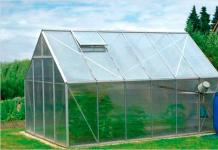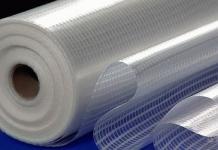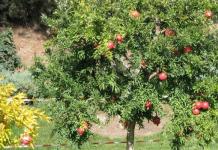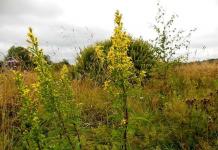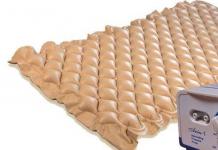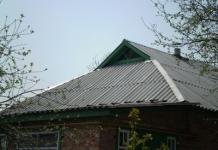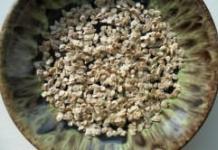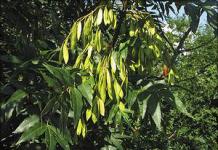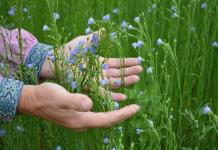Loch silvery is a tree-like bush, reaching four meters. The crown of the silver sucker is very decorative due to the oblong-ovate, shiny silver leaves up to 10 cm long. The leaves are usually bright green with a silver-metallic sheen inherent only in the sucker on the reverse side.
Shoots are reddish-brown from covering brown and rusty-brown scales. Fruiting begins at 7-10 years. Small bell-shaped flowers, silvery-white outside, yellow inside, arranged 1-3 in the axils of the leaves. They are very fragrant. The fruits are spherical silvery drupes, mealy and sweetish in taste, ripen in August - September. No matter how surprising it may seem, but the silver goof is the brother of sea buckthorn. The plants are really similar both in the structure of the fruits and in the shape of the bush itself, but still they are very different. The silver sucker belongs to the sucker family, which is quite interesting and rare in our area, and therefore more attractive.
 The silver sucker has not yet earned much attention in our country, however, according to many pundits, this is a matter of time, since in the current critical environmental conditions, a person needs affordable and safe vitamin products that can be obtained using the fruits, leaves, stems and even roots of this rare plant. A positive feature is that the plant is able to set fruits as a result of self-pollination, that is, a crop can be obtained by having only one plant in its garden plot.
The silver sucker has not yet earned much attention in our country, however, according to many pundits, this is a matter of time, since in the current critical environmental conditions, a person needs affordable and safe vitamin products that can be obtained using the fruits, leaves, stems and even roots of this rare plant. A positive feature is that the plant is able to set fruits as a result of self-pollination, that is, a crop can be obtained by having only one plant in its garden plot. The silver goof is very decorative during flowering, its flowers are elongated, bell-shaped with a surprisingly pleasant and unique aroma that attracts bees, an excellent honey plant, and honey from it is unusually pleasant and healthy.
sucker fruits
 The fruits are bright red, covered with silvery dots, in appearance resemble dogwood or dates. Ripe fruits are easy to collect, as they are attached to the shoots with thin long stalks. Usually the shape of the fruit is cylindrical, up to 2 cm long and about 1 cm in diameter. Inside each fruit there is a stone with a furrowed surface, surrounded by dark red flesh of a very pleasant sweet and sour taste, which is especially refreshing in conditions of lack of moisture. The taste of the fruit resembles a ripe persimmon or fig. Loja fruits can be eaten fresh (as a dessert), frozen and decorated with them in winter dishes, as well as dried and used in decoctions or infusions. Many delicious processed products can be prepared from the fruits of the multi-flowered sucker (the second name of gummi), this is luxurious jam, bright compotes, sweet jelly, rich juices and strong, pleasant-tasting wines.
The fruits are bright red, covered with silvery dots, in appearance resemble dogwood or dates. Ripe fruits are easy to collect, as they are attached to the shoots with thin long stalks. Usually the shape of the fruit is cylindrical, up to 2 cm long and about 1 cm in diameter. Inside each fruit there is a stone with a furrowed surface, surrounded by dark red flesh of a very pleasant sweet and sour taste, which is especially refreshing in conditions of lack of moisture. The taste of the fruit resembles a ripe persimmon or fig. Loja fruits can be eaten fresh (as a dessert), frozen and decorated with them in winter dishes, as well as dried and used in decoctions or infusions. Many delicious processed products can be prepared from the fruits of the multi-flowered sucker (the second name of gummi), this is luxurious jam, bright compotes, sweet jelly, rich juices and strong, pleasant-tasting wines.
The fruits of sucker contain many vitamins and are not inferior in their healing value to such a well-known culture as sea buckthorn. The meticulous Japanese, having examined all parts of this plant, found out that there is several times more vitamin C (ascorbic acid) in the leaves than in the well-known black currant and are currently developing the production of therapeutic herbal teas for the prevention of acute respiratory infections and influenza.
According to the Academy of Sciences, the fruits of the silver sucker are unique in that they contain seven essential amino acids for humans.  In Japan, these fruits are highly valued and are used to improve the cardiovascular system, gastrointestinal tract, and their main purpose is a vitamin and mineral food supplement, especially loved by little Japanese. The plant - Loch silvery completely fits into the seasonal cycle of our year, flowering usually falls on a calm frost-free time - the beginning - the middle of June, and the first ripened fruits can be obtained already in the middle - the end of July, sometimes at the end of August, if the summer is cool and rainy.
In Japan, these fruits are highly valued and are used to improve the cardiovascular system, gastrointestinal tract, and their main purpose is a vitamin and mineral food supplement, especially loved by little Japanese. The plant - Loch silvery completely fits into the seasonal cycle of our year, flowering usually falls on a calm frost-free time - the beginning - the middle of June, and the first ripened fruits can be obtained already in the middle - the end of July, sometimes at the end of August, if the summer is cool and rainy.
sucker breeding
Despite the relative unpretentiousness in cultivation, it is possible to propagate this plant vegetatively with great difficulty. Standard methods, such as layering (which has proven itself so well in most crops), will not help here, layering is difficult to root, and even then only in the second year. It is also impossible to obtain good standard seedlings in this way. It is known from the literature that sucker can be propagated by green cuttings in a greenhouse, but the personal experience of the author of the article suggests otherwise. Even in a greenhouse equipped with a fogging plant, rooted cuttings ended up with no more than 10-12%. The only reliable, and extremely effective way, proven more than once in practice, is sowing seeds. Shoots appear friendly and already in the first year the plants reach one meter in height.
Planting a sucker silver
The issue of obtaining planting material has been resolved, and now we are holding the cherished seedlings in our hands. Here comes the most important and responsible event - their landing. Since there is quite a bit of information about this culture, it is necessary to talk in more detail about the site selection technique, the planting itself and further care. So, planting - first of all, it is necessary to prepare the soil - dig it deep, level it with a rake, remove stones and weeds, the gummi root system is superficial, fibrous, and soil preparation plays a significant role in ensuring the further full growth of the plant. It is best to plant a sucker on elevated slopes with a southerly direction near a residential or country house, thereby protecting the plant from cold winter winds that can harm it.
Although this plant is unpretentious, it still requires neutral soil and does not like an excess of acid, so it is important to know the acidity of the soil in your area, and if this level is high, then you need to take care of adding lime.
Planting itself is best done in early spring or late autumn, when there is plenty of moisture in the soil. Plants are usually planted at a distance of 2-3 m in planting holes up to half a meter deep and up to one and a half meters wide. It is desirable to add a mixture of fertile soil (top layer) with compost, humus or sand into the hole, and at the bottom of the hole it would be great to arrange drainage from pebbles and stones, this is especially important on heavy clay soils, where water often stagnates and can destroy the root system. If the gardener wants to get a fully developed plant and provide himself with stable yields, then it is advisable to add up to 30 g of nitrogen fertilizers, 200-250 g of double superphosphate and up to 700 g of wood ash to the soil mixture.
When planting, the root neck of the plant should be deepened by 5-8 cm, and after planting, it is imperative to water the plant and mulch the topsoil with humus.
Loch care
Further care of the sucker plant consists in periodic feeding with compost, wood ash and double superphosphate, as well as in loosening the near-trunk strip. In winter, it is advisable to cover the bushes with snow or brushwood in order to avoid freezing of the shoots. The plant begins to bear fruit very early and already at the age of five it can produce up to 4 kg of fruit per bush, and this figure grows every year, reaching a maximum of 30 kg per plant. The bush is durable and can bear fruit in one place for up to 25 years.
The silver sucker deserves the attention of gardeners due to the amazing taste of berries, their healing properties and high crop yields.
The silver goof is unpretentious, photophilous, but puts up with partial shade. It can successfully grow on soils of various moisture and fertility. Winter-hardy, but annual shoots sometimes freeze slightly. Grows slowly. It tolerates pruning well, gives a lot of root growth, spreading far from the mother bush, on light soils - up to 8 m.
In green building, goof is a valuable material for creating contrasting spots, effective for single and group plantings. Unsuitable for hedges, as it gives a lot of root shoots.
They have many useful properties. This has been used since ancient times in their homeland in North America by the indigenous population as a dietary supplement and medicine. Other well-known names include "Nebraska currant" and "buffalo berry". In this article you can find information about Shepherdia silver, its beneficial properties and contraindications for use.
What is this plant?
Belongs to the Lokhov family and is a rather undersized, whose homeland is considered to be North America. It bears fruit with red-colored berries, which are covered with barely noticeable whitish dots. Bushes can bear fruit annually for 40-50 years, while each can collect 15-20 kg of berries.
Did you know? The Lokhov family includes only 3 types of plants, the distinguishing feature of which is the presence of hairs or scales on the leaves and shoots, which give them a silvery tint.
Shepherdia, also known as buffalo berry, is quite edible for humans in its raw form, but has a slightly sour-bitter taste, and after eating it leaves a feeling of dryness in the mouth. These berries serve as a source of food for many wild animals, primarily for bears, in addition, they are eaten by the larvae of some insect species.
Nutritional value and calories
The product has a rather meager nutritional value, but it carries a very large amount of other biologically active substances. The calorie content of 100 g of red is only about 28 kcal.
100 g of the raw product also contains: protein - 0.5 g, fat - 0.2 g, carbohydrates - 3.7 g. The rest of the weight falls on dietary fiber and water, which any berry, based on its biological structure, pretty rich. 
Chemical composition
Shepherdia is the best natural source of vitamins and microelements. By the amount of vitamin C it contains, it is able to compete with many citrus fruits. As for the catechins and oily substances that make up, here they overtake the global recognized leader in these parameters -. The main chemical composition of the berry can be characterized as follows:
- various sugars;
- many organic acids;
- ascorbic acid;
- substances with tannic properties;
- pectin;
- carotene;
- vitamins C and P;
- lipokines.

Did you know? The composition of the fruits of this shrub also includes tetrahydroharmol, which, when ingested in large quantities, acts as a psychedelic.
Pharmacological properties
The fruits of Shepherdia silvery have many pronounced beneficial properties. The leukoanthocyanins and catechins contained in them help to increase the strength and elasticity of the walls of veins, arteries and arterioles, and also reduce their fragility. Carotene, present in excess in fruits, improves the functioning of the visual analyzer and prevents the development of many ophthalmic diseases.
In addition, carotene is the initial substance that our body needs for the synthesis of vitamin A, and therefore the use of red has a positive effect on the condition of the skin.
Vitamin C, which is part of the berry in large quantities, helps to increase and strengthen the immune function of the body, helps to better cope with the processes of resuming normal work after suffering various acute respiratory viral infections and influenza.
Vitamin P is responsible for maintaining the correct structure and tone of blood vessels, strengthens the capillary network, and has an anti-atherosclerotic effect. In this regard, we can conclude that the use of shepherdia is an excellent prevention of strokes and heart attacks.  Since these fruits are dietary products, they are very often recommended for people seeking to lose weight, and for a variety of diseases of the gastrointestinal tract. Tannins, which are found in large quantities in this berry, have a range of different effects: astringent, bactericidal, anti-inflammatory and hemostatic.
Since these fruits are dietary products, they are very often recommended for people seeking to lose weight, and for a variety of diseases of the gastrointestinal tract. Tannins, which are found in large quantities in this berry, have a range of different effects: astringent, bactericidal, anti-inflammatory and hemostatic.
The use of fruits
Shepherdia has not found wide application in traditional medicine, but is actively used in folk and culinary. They can be found as components in various preparations and bioactive supplements.
Treatment
The fruits of this are widely used and recommended by many traditional healers for the treatment of various viral infections and influenza, as well as an immunostimulant in the process of recovering the body from the effects of the latter. It is widely used as a vitamin supplement to the traditional treatment of these diseases. It is used to maintain and normalize the work of the gastrointestinal tract and the cardiovascular system.
Important!Traditional pharmacotherapy should not be abandoned in favor of treatment with shepherdia, but it can serve as an excellent addition to traditional treatment regimens.

cooking
One of the main methods of using these berries in cooking is the production of various alcoholic beverages from them by infusion. At one time, Ivan Vladimirovich Michurin himself spoke positively about various tinctures obtained using red sea buckthorn. In addition, compotes, jelly, jam, various sauces and unusually tasty seasonings can be prepared from it.
Contraindications and harm
Bison berries should not be eaten if you have an individual intolerance to it or are a pronounced allergic person. During lactation, pregnancy and in childhood, it is necessary to consult a doctor before use. 
They bought seedlings of sea buckthorn - a "boy" and a "girl", in anticipation of a vitamin harvest, they cherished the bushes for 3-4 years, and they turned out to be of the same sex. More often, male, because it gives a lot of shoots, which is what unscrupulous sellers use. How can one not “buy in” on varieties of self-fertile sea buckthorn, which allegedly do not need a pollinator? The fact that breeders are working on this has been talked about for a long time. But is there a result, or are businessmen again running ahead of the steam locomotive's smoke, passing off wishful thinking? Let's figure it out.
Fruiting is the prerogative of female specimens of sea buckthorn
What is needed for sea buckthorn to become self-fertile?
Sea buckthorn is a self-fertile plant. Nature decreed that each representative of this shrub is unisexual - on some there are only female (pistil) flowers, on others - male (staminate). Pollination occurs with the help of wind. In order for berries to start on the female bushes, it is necessary that a pollinator grows in the area - at least one per 10 plants, and preferably 4–5.
Such representatives of the flora are considered self-fertile, in which: a) stamens and pistils are located in the same flower; b) female and male flowers bloom on the same plant.
In order for sea buckthorn to become self-fertile, it is necessary to change its genetic apparatus. It is necessary to influence the inherited traits in such a way as to break the usual DNA chains, to create completely new plant forms that are not found in nature. Perhaps these will be parthenocarpic hybrids capable of setting fruits without pollination at all.
In breeding for this purpose, special substances are used - chemical mutagens. They process seeds and thereby start a chain of genetic mutations. High doses of mutagens lead to unpredictable changes. One of these mutations is the appearance of prototypes of self-pollinated sea buckthorn. But this sign is unstable, not all plants grown from treated seeds show self-fertility. Therefore, we can talk about research in this area, but not about stable varieties.
Incentive selection has recently been used quite widely. Mutagens in small doses make it possible to create super-yielding, large-fruited varieties, to get rid of unnecessary features (spiky shoots, excessive growth). Breeders with the help of seed treatment accelerate the ripening of fruits, affect their taste characteristics.
"Good faith" fallacy
Perhaps there are lucky ones who managed to get seedlings obtained from seeds treated with mutagens. Information about such planting material is indeed found, but there is no guarantee that it is offered to you.
Most often, gardeners are mistaken about the self-fertility of their sea buckthorn, without even realizing the mistake. How and why is this happening?
Relatives of vitamin culture
Residents of the Ural region, Siberia, Altai are unlikely to confuse sea buckthorn with some other berry crop, but in places remote from the natural habitat of the shrub, its close relatives can be mistaken for self-pollinated varieties.
Shepherdia silver is sometimes called red sea buckthorn. The plant is quite thermophilic, therefore it is more common in the south of Russia, in Ukraine. Shrubs have a lot in common:
- belonging to the same family Lokhovye;
- oblong silvery foliage;
- small orange-red drupes collected in dense cobs;
- sour taste of berries.
Shepherdia, by the way, is also a dioecious plant. But if you take it for sea buckthorn, then you may not know that a pollinator is growing somewhere nearby.
Another relative of our heroine is the narrow-leaved sucker. Far from gardening, a person may take it for a kind of self-pollinated sea buckthorn, as the plants look like whorled silvery leaves, prickly shoots and tassels of yellow-brown berries. Lough - the plant is really self-fertile.
grafted plants
Some gardeners, instead of planting a pollinator separately, graft several of its branches into the crown of a female plant. This is convenient for many reasons.
- An empty shrub does not take up space in the garden.
- If the branch dries up, you can graft another, and not look for a new seedling.
- Unlike male specimens, a grafted female plant produces much less growth.
Having bought a seedling of an already grafted sea buckthorn, and without specifying why a pollinator is not needed, inexperienced gardeners perceive it as a self-pollinating variety. But if you look closely at the shrub in spring, you will see that the buds on the male branches are 2-3 times larger, and the flowers are different.
Cases of fruiting "male" shrubs
Sometimes one can observe how single fruits are tied on male specimens of the culture. Some scholars consider this evidence that the plant was originally a "hermaphrodite" and the separation of the sexes occurred later. Experimenting with such material, they are trying to develop self-fertile varieties. But more often, the fruiting of "boys" is the result of a genetic mutation caused by chemicals.
If the delusion factor is excluded, it remains to be assumed that you are growing a truly self-fertile variety of sea buckthorn, which has acquired its unusual characteristics as a result of a natural or artificial mutation.
Self-fertile is not always the best
Let's see what advantages "feminists" have who do not need pollination on the side. On sites that sell seedlings of such plants, we were able to find the following:
- sea buckthorn thornless;
- self-fertile;
- the berry is large, on a long petiole.
And nowhere is there a word about the taste characteristics, the vitamin composition of the fruit, the yield, the way the drupes are attached to the cob. Not to mention who is the originator.
Before deciding to buy, compare the description of the proposed product with dioecious varieties, many of which have much more attractive characteristics.
There are among them (up to 24.5 kg), Botanical (up to 20 kg), Panteleevskaya (17.5 kg), Sudarushka (15 kg) and the size of berries - Augustine, Essel, Naran.
Delicious berries can boast Zhemchuzhnitsa, Tenga, Jam.
Record holders for the amount of ascorbic acid, carotene, bioflavonoids are Vitaminnaya, Zhivko, Pepper.
If you need a thornless shrub, there is Augustine, Minus, Solar.
How not to let yourself be deceived?
If you decide to purchase sea buckthorn varieties "Self-fertile", insure yourself to the maximum against fakes.
- Buy a seedling where you can make a claim - in a fruit nursery, garden center, specialty store. The best option is directly from the manufacturer.
- Ask in detail what the essence of the self-fertility of a plant is, how this characteristic was obtained. To date, the only option for such selection is a mutagenic effect. All other explanations speak of "forgery".
- Avoid buying from dubious sites. The statement about “a limited number of seedlings” should be especially alert - the guys clearly want to create a stir around the product.
- Do not buy a “new selection” from your hands, in spontaneous markets, from grandmothers. Even if we assume that this is the “offspring” of self-pollinated sea buckthorn, it is not a fact that it will repeat maternal characteristics.
Although, most likely, you will not find anything like this in fruit and berry nurseries. A serious producer will not risk his reputation by selling seedlings with unstable characteristics. Such products almost always come to the store from private nurseries, which are engaged in the reproduction of varietal material by cuttings, but not in any way by selection.
As you can see, with the self-fertility of sea buckthorn there are more questions than answers. Therefore, rather than buying a "pig in a poke", it might be better to look for good zoned ones that will delight you with their beautiful appearance, large tasty berries, and productivity?
How to distinguish between male and female sea buckthorn plants:
There are only 3 genera in the sucker family and about 55 species distributed in Europe, Asia and North America. Lokhovye - trees and shrubs with characteristic pubescence of corymbose scales or stellate hairs. Their leaves are alternate or sometimes opposite, like those of Shepherdia, on short petioles, entire and entire, evergreen or falling. All three genera are characterized by the presence of root nodules with nitrogen-fixing bacteria, due to which suckers can also grow on very poor soils. Flowers are axillary, solitary, in few-flowered bunches or in short racemes. In sucker (Elaeagnus) the flowers are bisexual or polygamous (bisexual and male), while in the remaining two genera they are dioecious, very rarely bisexual. The perianth is represented only by a calyx, which in bisexual and female flowers is more or less tubular, while in male flowers it is cup-shaped or almost flat. The calyx is usually 4-lobed, but in sea buckthorn (Hippophae) it is 2-lobed. There are usually 4 stamens, but shepherdia has 8; filaments of stamens are very short, attached to the throat of the calyx tube. Usually inside the tube of the calyx there is a well-developed disk in the form of glandular outgrowths, alternating with stamens; Sea buckthorn has a disk only in male flowers. Single-carpeted gynoecium with a long filiform style ending in a capitate stigma. The fruit of the suckers is a nut enclosed in the remaining and overgrown fleshy tube of the calyx. This formation is very similar to a drupe, but botanists consider it correct to call it a false drupe. Seed with a direct embryo and no endosperm or with poorly developed endosperm. The flowers of sucker and shepherdia are pollinated by insects, but in sea buckthorn they are, in all likelihood, wind-pollinated. Unfortunately, the pollination biology of suckers is almost not studied. As for the distribution of fruits, it is produced by birds, and in the sucker also, possibly, by mammals. Sea buckthorn fruits are spread both by birds and sometimes by water (rivers, mudflows).
The largest genus in the family sucker (Elaeagnus) with about 50 species. Several species of sucker are found in Southern Europe, Western and Central Asia and North America. But most species are common in East and especially in Southeast Asia. One Asian species of sucker reaches North East Queensland. Types of sucker - small trees and shrubs, deciduous or more often evergreen, often with thorns (reduced and modified branches). The evergreen species have leathery leaves and typically flower in the fall and bear fruit in the spring. The leaves of deciduous species are not leathery, they bloom in spring and bear fruit in autumn. Flowers axillary, solitary or in bunches, fragrant. The calyx is bell-shaped or cylindrical, silvery on the outside, yellow or white on the inside. False drupes are mealy, mostly edible. In the former USSR, there are 5 species growing in the Caucasus and Central Asia.
Sea buckthorn (Hippophae), a genus of plants in the goat family. 3 species growing mainly in the temperate zone of Eurasia. In the USSR (in the west and south of the European part, in the south of Siberia, in Central Asia, and in the Caucasus), one species is O. rhamnoides (H. rhamnoides). Shrub or tree up to 11 m high with thorny branches. The leaves are linear or linear-lanceolate, silvery from stellate-scaly pubescence. Flowers dioecious, small; staminate - with a bipartite perianth and 4 stamens, pistillate - with a tubular bilobed perianth. The fruits are drupe-shaped, with juicy fleshy pulp, as if sticking around the stem (hence, perhaps, the name). O. grows along the shores of seas, lakes, in floodplains of rivers, streams, on pebbles and sands, in mountains at an altitude of up to 2100 m. O. is cultivated as a fruit and ornamental plant, as well as to fix sands, landslides, slopes, ravines, for living fences. The fruits are rich in vitamins, used to make tinctures, liqueurs, jams, to obtain medicinal sea buckthorn oil, consisting of a mixture of carotene and carotenoids (180 mg%), tocopherols (110 mg%) and glycerides of oleic, linoleic, palmitic and stearic acids. Applied externally in the treatment of burns, bedsores, radiation damage to the skin, as well as inside with stomach ulcers. O. leaves serve as tanning raw material.
The third genus of the sucker family - Shepherdia (Shepherdia), distributed in North America from Alaska and Newfoundland to northern Mexico. These are shrubs with opposite leaves, silvery pubescent from below or from both surfaces and with oval or ovoid fruits 5-8 m long. Shepherdia grows along river banks. It is of known practical interest. In addition to edible fruits, one of the species - Canadian Shepherdia (S. canadensis) - is devoid of thorns. In addition, shepherdia gives excellent survival rate when grafted on sea buckthorn.
Loch multiflorous or gumi (Elaeagnus multiflora)
The new culture - the multi-flowered sucker, or gumi, is a representative of one of three very close genera of the sucker family: sea buckthorn, sucker and shepherdia. In total, about 40 species of sucker are known in the genus, of which in the CIS (in Central Asia and the Caucasus), narrow-leaved, oriental, silver and edible suckers are widely used as a fruit plant. Loch many-flowered is cultivated mainly on Sakhalin. Its homeland is Japan and China.
Fruits containing, like all suckers, biologically active substances, have healing properties and are recommended for gastrointestinal diseases, improve blood circulation, and have a tonic effect. In Japan, gumi is considered to be healing, restoring youth to people. Loja fruits contain 15% dry matter, 9-14% sugars, 0.004-0.008% vitamin C (ascorbic acid), 0.05% pectin, 0.4% catechins. Salts of phosphorus, potassium, and calcium were also found. The leaves of the sucker are also distinguished by a high content of ascorbic acid, especially in July - 0.25%. Ascorbic acid is also found in flowers - up to 0.15%.
Features of biology. Gumi is a small shrub with a height of 1 - 1.5 m. The leaves are elliptical at the top, entire, the leaf blade is silver-green above, with a fluffy coating, and has dark brown scales below. The flowers are bisexual, drooping, regular in shape, very fragrant, attract many pollinating insects. The fruits are oblong or oval, with blunt ends, densely dotted with silvery-white dots, 1-2 cm long, weighing 1.5-2 g. The color of the fruit changes from green to yellow and red as it ripens. According to different people, the taste of gumi resembles the taste of apples, grapes, cherries, currants, bird cherry. The fruits are very tasty when fresh. For harvesting for the future, it is recommended to use them grated with sugar, preferably with the addition of some sour fruits, since gumi fruits are very sweet.
Vegetation begins in the second half of April, flowering - in mid - late May, fruit ripening - in late June - early July. The basis of high productivity of plantings is the right choice of a place for planting. Gumi are planted in places protected from the wind. Lowered places are also not recommended for planting due to the accumulation of cold air there, and in the spring - stagnation of melt water.
Lohu multiflora is characterized by high precocity of buds. During one growing season, plants form two or even three orders of branching. As a result, branched annual shoots are formed, and the crown thickens unnecessarily. The generative buds of the multiflorous sucker are fully formed already in the year of laying. Plants have a very short dormant period - 30 days, after which they are ready to resume vegetation. An important biological feature of the root system of the many-flowered sucker, like shepherdia, sea buckthorn, is the ability to fix atmospheric nitrogen with root nodules. The flowers are bisexual, drooping, regular in shape, very fragrant, attract many pollinating insects. The plant is an excellent honey plant. The fruits vary greatly in shape (from round to cylindrical), weight (0.7-2.1 g), taste (from sweet to sour and tart).
Landing and care. At the age of 10, the diameter of the crown at the sucker reaches 2-2.8 m, so the seedlings are planted according to the 4 X 2 m scheme. Plants are planted in pits with a diameter of 35-40 cm, pre-filled with fertilizers: 10 kg of manure mixed with the top layer of the earth , 200-300 g of superphosphate. The aerial part of the seedling is cut off before planting, leaving branches 25-30 cm high to obtain a branched bush in the first year. The root neck is deepened by 4-6 cm. Seedlings are watered abundantly after planting. Caring for a multi-flowered sucker is similar to caring for sea buckthorn, but it is more demanding on soil fertility, moisture, and light. Loch requires regular loosening and watering. In subsequent years, when cultivating the soil for each square. m near the trunk circle contribute 10-12 kg of humus or compost, 100 g of superphosphate and 30 potassium salt. In the first 10 years, they are limited to sanitary pruning, frozen, shrunken and broken shoots are removed. In the future, the bushes are partially thinned out and rejuvenated. With good care, the fruit yield from a 5-6 year old bush is 6-8 kg.
Varieties and forms. Within the species, the plants of the polyflorous sucker vary sharply in habitus, in particular, in the shape of the crown (from compressed pyramidal to highly spreading), the roundness of the shoots, the shape and color of the leaves, the size and taste of the fruits. Forms with early- and late-ripening buds have been identified. The multi-flowered sucker is already on its way to our gardens. The first, and so far the only collection of the species - 465 specimens - was created at the Sakhalin Research Institute of Agriculture. The first varieties of this new culture have already been created here. 4 varieties are registered in the State Register. Three of them are selected by the Sakhalin Research Institute of Agriculture. In 1999, a variety appeared in the State Register Sakhalin first, in 2000 - variety Moneron. In 2006, gumi varieties such as Crillon(also a variety of Sakhalin selection) and Taisa(Moscow selection).
Variety Crillon is a late maturing variety. The berries are medium, cylindrical, bright red, sweet, very good taste. Tasting score fresh and frozen 5 points. Berries are distinguished by a high content of vitamin C - 111 mg per 100 g of fruit. For comparison: the famous antonovka contains 7-13 mg per 100 g of fruit.

Pests and diseases. The plant is resistant to pests and diseases.
Growing planting material. Loch multiflorum propagated by seeds, layering and dividing the bush. Seeds (pits) differ from seeds of other plants - with grooves, elongated, in the form of "sticks", narrowed towards the ends. Seed propagation is the simplest and most accessible for amateur gardeners, and although seedlings do not repeat the signs of the mother plant, deviations are often in the direction of useful properties. After harvesting the fruits in two days, the seeds are washed from the pulp and stored until stratification in paper bags in a cool room. In October, they are mixed with wet river sand or sawdust (also wet) and kept until sowing buried in the soil at a depth of 20-30 cm. In winter, this place should have a snow cover of up to 1 m. substrate in a thin layer on a polyethylene film and constantly moisten. Sprouted seeds are sown in greenhouses, greenhouses or boxes in the apartment. With good care during the summer, seedlings grow 30-50 cm high. For the winter, they are carefully covered or after a dormant period (30 days from the onset of stable negative temperatures) they are transferred to growing in a heated room. When 3-4 shoots grow on the seedlings, and the length of the roots reaches 20-22 cm, the plants are transplanted to a permanent place in the garden.
Goof umbrella Akigumi (lat. Elaeagnus umbellata)
 Motherland East Asia. A tree up to 2-4 m tall with flexible outstretched branches, which have spines at a young age. It has beautiful silvery shoots and elliptical leaves. Fragrant flowers appear in July, the fruits are drupes with an elliptical stone and sweet mealy pulp. The plant is valuable because it simultaneously gives a huge harvest of bright red, very tasty berries. Fruits in 8-9 years, the fruits ripen in October. The plant is unpretentious, photophilous, drought-resistant, with good winter hardiness, good honey plant. It is of interest as an ornamental plant. It tolerates a haircut well, when planted "on a stump" it gives abundant shoots, which allows it to be used to create hedges. Recommended for use in single and group plantings, on light edges, when creating contrasting groups.
Motherland East Asia. A tree up to 2-4 m tall with flexible outstretched branches, which have spines at a young age. It has beautiful silvery shoots and elliptical leaves. Fragrant flowers appear in July, the fruits are drupes with an elliptical stone and sweet mealy pulp. The plant is valuable because it simultaneously gives a huge harvest of bright red, very tasty berries. Fruits in 8-9 years, the fruits ripen in October. The plant is unpretentious, photophilous, drought-resistant, with good winter hardiness, good honey plant. It is of interest as an ornamental plant. It tolerates a haircut well, when planted "on a stump" it gives abundant shoots, which allows it to be used to create hedges. Recommended for use in single and group plantings, on light edges, when creating contrasting groups.
Goof narrow-leaved Jida (lat. Elaeagnus angustifolia)
 Loch narrow-leaved (popular names: wild olive, dzhida, corga, zhiida, kush zhiida, zhide, pshati, dzhicherdak, igda) is a tree-like shrub from the loch family with red-brown bark, large stem spines, narrow lanceolate leaves and small, strongly fragrant , bright yellow flowers, refers to good early honey plants. The fruits are oval, mealy, yellowish-brown drupes, shaped like an olive. The fruits have a sweet, mealy, slightly astringent taste. The plant reaches a height of 6m. Blossoms in May-June, fruits ripen in September-October. There are cultivars with mealy, brownish-brown fruits. In the wild, sucker is found in forests and along the banks of reservoirs in the south of the European part of Russia, in the Caucasus, in Siberia and Central Asia, in North America. As an ornamental and fruit plant, it is bred in gardens and parks, shelterbelts, and also grows along river banks, on the edges of forests. Lough is a very ancient cultivated plant. Cultural forms are devoid of spines. There are many large-fruited varieties of this crop. These varieties are the result of centuries of selection. Loja fruits are astringent, very sweet, containing up to 40% sugar, consisting of glucose and fructose, and up to 36% tannin. In addition, they contain about 11% protein, organic acids, nitrogen and dyes, potassium and phosphorus salts. The bark and seeds contain alkaloids, and the leaves contain vitamin C (up to 350 mg%). The fruits are eaten raw or used in the preparation of homemade flour products, candied fruits, delicious wines with a peculiar aroma. For medicinal purposes, fruits, leaves, flowers are used. The fruits have anti-inflammatory, astringent, analgesic, diuretic, antihelminthic and enveloping effects and the ability to increase sputum in diseases of the respiratory organs.
Loch narrow-leaved (popular names: wild olive, dzhida, corga, zhiida, kush zhiida, zhide, pshati, dzhicherdak, igda) is a tree-like shrub from the loch family with red-brown bark, large stem spines, narrow lanceolate leaves and small, strongly fragrant , bright yellow flowers, refers to good early honey plants. The fruits are oval, mealy, yellowish-brown drupes, shaped like an olive. The fruits have a sweet, mealy, slightly astringent taste. The plant reaches a height of 6m. Blossoms in May-June, fruits ripen in September-October. There are cultivars with mealy, brownish-brown fruits. In the wild, sucker is found in forests and along the banks of reservoirs in the south of the European part of Russia, in the Caucasus, in Siberia and Central Asia, in North America. As an ornamental and fruit plant, it is bred in gardens and parks, shelterbelts, and also grows along river banks, on the edges of forests. Lough is a very ancient cultivated plant. Cultural forms are devoid of spines. There are many large-fruited varieties of this crop. These varieties are the result of centuries of selection. Loja fruits are astringent, very sweet, containing up to 40% sugar, consisting of glucose and fructose, and up to 36% tannin. In addition, they contain about 11% protein, organic acids, nitrogen and dyes, potassium and phosphorus salts. The bark and seeds contain alkaloids, and the leaves contain vitamin C (up to 350 mg%). The fruits are eaten raw or used in the preparation of homemade flour products, candied fruits, delicious wines with a peculiar aroma. For medicinal purposes, fruits, leaves, flowers are used. The fruits have anti-inflammatory, astringent, analgesic, diuretic, antihelminthic and enveloping effects and the ability to increase sputum in diseases of the respiratory organs.
Silver goof (lat. Elaeagnus commutata)
 Small tree or shrub Shoots are covered with golden scales. It has a dense oblong-ovate shiny silver foliage up to 10 cm long, which gives a special decorative effect to the crown of the plant. The fruits are spherical, silvery drupes up to 1 cm long. A small tree or shrub. The shoots are covered with golden scales. It has a dense oblong-ovate shiny silver foliage up to 10 cm long, which gives a special decorative effect to the crown of the plant. The fruits are spherical, silvery drupes up to 1 cm long.
Small tree or shrub Shoots are covered with golden scales. It has a dense oblong-ovate shiny silver foliage up to 10 cm long, which gives a special decorative effect to the crown of the plant. The fruits are spherical, silvery drupes up to 1 cm long. A small tree or shrub. The shoots are covered with golden scales. It has a dense oblong-ovate shiny silver foliage up to 10 cm long, which gives a special decorative effect to the crown of the plant. The fruits are spherical, silvery drupes up to 1 cm long.
Shepherdia silver (lat. Shepherdia argentea)
silver shepherdia- a particularly valuable culture, one of the few that are valued for both beauty and very tasty fruits. However, despite the fact that this culture is valuable, it is, alas, not widely distributed. Even in amateur gardening, it is quite difficult to meet her plants, but it is too early to talk about industrial scale. However, recently there has been a positive trend in consumer demand for the fruits of crops that were not previously found on the shelves. This trend has not bypassed shepherdia, because its fruits are rich in biologically active substances, have high nutritional and significant medicinal properties, and the culture itself is characterized by undemanding cultivation and ease of reproduction. Under natural conditions, this culture is found in North America, where it was first used as a fruit plant by the native Indians. Shepherdia became more seriously interested relatively recently - in the 20th century, then in the Canadian provinces they began to plant Shepherdia plantations widely and in large volumes, and carried out selection by selecting the most large-fruited forms. Our great IV Michurin, who seriously believed that shepherdia would take a significant place in Russian industry, did not deprive her of attention. His research on this crop and such far-reaching plans for it are not unfounded, because the fruits of shepherdia are a pantry of vitamins, they contain up to 30% of dry matter, more than 20% of sugars, and about 4% of organic acids. The fruits are rich in catechins (more than 18%), tannins, they contain vitamin C, and a considerable amount of it - about 250 mg%, P-active compounds. The well-known sea buckthorn, which is considered the queen of medicinal crops, falls short in comparison with the fruits of shepherdia. Without going into a retelling of all the advantages and merits of the fruit, we will only say that in terms of the content of the most famous vitamin C, its fruits are several times superior to sea buckthorn! And if you consider that it is incomparably easier to collect Shepherdia, it remains only to support the great breeder in his conclusions!
Naturally, such fruits, valuable in terms of the content of leukoanthocyanins, carotenoids, catechins and other substances indispensable for humans, must be used for therapeutic and prophylactic purposes. Shepherdia fruits help to increase the strength and elasticity of the walls of blood vessels, this is very important, as it dramatically reduces the risk of heart attacks and strokes. The fruits of this wonderful plant are used both fresh and dried, they are used to prepare processed products - jams, jellies, compotes, seasonings and tinctures. Yes, and as an ornamental plant shepherdia, attracting attention with silvery foliage and a scattering of fruits, is often used. It decorates group plantings, the “edible” hedge is magnificent from it. Shepherdia also feels good in urban conditions, breathes air consisting of dust and gas and is tolerant of a “naked” haircut.
BIOLOGICAL CHARACTERISTICS
Shepherdia silver belongs to the curious family of suckers and the genus Shepherdia, which combines 3 species. This culture can be equated with sea buckthorn or sucker, because there is only one family ... The plant is quite promising and can be safely recommended for introduction into culture, in its homeland (North America) it is loved and affectionately called "Nebraska currant". Under natural conditions, sheferdia looks more like a tree than a shrub, well, how can a plant be called a shrub, often reaching more than 6 meters?! The plant is dioecious, so if you want to get fruits, you will have to create a "family". It is possible to distinguish a “real man” from a “modest girl” of shepherdia only by the kidneys, and even then only during the dormant period - as befits a man, the kidneys of a plant are much larger and rounder than those of a woman. Flower buds, and therefore fruits, are formed on annual shoots, therefore, by looking into the future, one can roughly estimate the yield by looking into the future.
The leaves are quite interesting - opposite, oblong-lanceolate, less often narrowly elliptical, silvery, reaching 6.5 cm in length. Escapes are circled. Flowering, depending on the weather, begins at the end of April, or (more often) in mid-May, usually a temperature of 6 ... 8 ° C is enough. It blooms for a relatively short time, up to 10 days. The flowers are unisexual, yellow, rather small, collected in short spike-shaped inflorescences, which are pollinated by insects. The inflorescences do not bloom at the same time, which is a good feature during frosts, which are not rare during this period - only blossoming flowers die, which saves a significant part of the crop. Ripe fruits are drupes, attractive red in color, weighing up to 0.6 g. Usually, you can enjoy the fruits already in August, less often in September, if the weather does not indulge in high temperatures. The taste of ripe fruits is sweet and sour, with a rather original flavor and completely devoid of astringency inherent in still unripe fruits, they vaguely resemble sea buckthorn fruits, but are much tastier and sweeter than them.
Shepherdia silvery plant is very light-loving, rather winter-hardy and drought-resistant, undemanding to soils, ecologically plastic and feels good in rather contrasting climatic conditions - in the middle lane, in the Urals, in the Volga region, Siberia and even in the Caucasus. A positive fact is that this culture is quite resistant to pests and diseases, which makes it possible to grow environmentally friendly products. Sheferdia silver enters fruiting already at the age of 5, and vegetatively propagated plants even earlier - in the 2-3rd year. The yield is quite high, so a young plant can produce up to 5 kg, and an adult with proper care and up to 15 kg of fruit! Shepherdia is not characterized by the frequency of fruiting, and the productive age exceeds 50 years.
ABOUT VARIETIES
Shepherdia silver is quite seriously selected in Ukraine, there are several forms that can rightfully be considered varieties, there are similar forms in the USA. The most promising direction of breeding work with this crop is its combined crossing with sea buckthorn, the purpose of which is to create a plant that combines the positive properties of these crops, i.e., has oil content, yield, large-fruited, bright color, high taste, resistance to diseases and pests .
AGRICULTURAL TECHNIQUE
Shepherdia silver should be planted only in a well-lit place with soil that is deeply drained and has a sandy or loamy mechanical composition. Low places, especially with close standing groundwater, should be avoided. There should be both male and female plants on the site, usually one male is enough for 4 female plants, the distance between the trees is left equal to 1.5-3 m. the plant can be grafted with a cutting into the female crown. If you have acquired two-year-old seedlings, then for them it is necessary to prepare planting pits 60-70 wide and up to 50 cm deep, which are filled with soil of the upper fertile layer. After planting, watering is necessarily carried out, and then mulching with humus, peat or half-rotted manure with a layer of 3-5 cm. In the future, it is advisable to keep the near-stem circles, even in adult plants, in a loose and weed-free state, an unchanged layer of mulch helps this. Considering that the root system of the plant lies rather superficially, tillage should be carried out no deeper than 7-8 cm. root "on the ring" with a sharp pruner.
A few words about the formation - usually the plant is formed in the form of a tree with a rather low stem (not higher than 40 cm) or (less often) in the form of a bush. Since the shoots grow quite quickly, the crown must be systematically thinned out. To facilitate the care of the crown and harvesting, it is periodically reduced, usually to a height of 2-2.5 m, this is done by shortening the vertical branches to lateral branches. With age, the annual growth of plants becomes less and less, and after this, the yield naturally falls, so about once every 3-5 years it is necessary to carry out rejuvenating pruning, shortening the main and side branches by 2-3-year-old wood. Such pruning, distinguished by its simplicity, helps to enhance the growth of shoots, increase yields and increase fruit size.
Ripe fruits are harvested in September, they are easily separated from the branch and therefore you can simply shake them off on a film spread under the crown. The only inconvenience is the thorns on the branches.
Sea buckthorn (lat. Hippophae rhamnoides)
 Sea buckthorn belongs to the loch family. It is a bush or a small tree 4-15 m high. The branches are prickly, the bark of the branches and the trunk is dark gray, wrinkled. The leaves are alternate, narrow, linear or linear-lanceolate, almost sessile, dark green above, silvery below. The plant is dioecious, the flowers are heterosexual. A plant with female flowers bears fruit, therefore, for effective fruiting, at least one or two male trees should be planted between female trees for pollination. The flowers appear at the same time as the leaves grow. The fruits are golden yellow or orange, edible fleshy drupes, sitting on very short stalks. When there are a lot of berries, it seems that the fruits stuck around the branches, which, apparently, served as the basis for the name of the plant. Blossoms in April - May, and the fruits ripen in September - October.
Sea buckthorn belongs to the loch family. It is a bush or a small tree 4-15 m high. The branches are prickly, the bark of the branches and the trunk is dark gray, wrinkled. The leaves are alternate, narrow, linear or linear-lanceolate, almost sessile, dark green above, silvery below. The plant is dioecious, the flowers are heterosexual. A plant with female flowers bears fruit, therefore, for effective fruiting, at least one or two male trees should be planted between female trees for pollination. The flowers appear at the same time as the leaves grow. The fruits are golden yellow or orange, edible fleshy drupes, sitting on very short stalks. When there are a lot of berries, it seems that the fruits stuck around the branches, which, apparently, served as the basis for the name of the plant. Blossoms in April - May, and the fruits ripen in September - October.
Cultivation
The plant is light and thermophilic, but frost-resistant enough. Sea buckthorn is a dioecious plant, which means: some plants have only female flowers that produce fruits, others have male (stamen) flowers, from which pollen comes to pollinate female flowers. That is why in the areas of cultivation of bushes and trees, Sea Buckthorn should be planted on about 10 female trees - one male. If the sea buckthorn garden is small, it is enough to graft a sprig of a male tree onto the trunk of a female tree. The tree is unpretentious to soil conditions, but prefers light soils. Does not tolerate flooded areas, waterlogging, prefers neutral soils. In places where sea buckthorn grows, the groundwater level should not exceed 0.5 m. The best fertilizers for sea buckthorn are organic fertilizers - last year's manure, composts, and from mineral fertilizers - superphosphate. Sea buckthorn does not like nitrogen fertilizers.
The plant is propagated by seeds, as well as by cuttings harvested in autumn before the onset of severe frosts and kept at a temperature of -3-5 ° C, in sand or under snow. Sea buckthorn is more often propagated by root processes if they appear at the sites of injury to the root system. Caring for Sea Buckthorn It consists in weeding and loosening the tree trunks to a depth of 7-10 cm, in periodic feeding, watering and pruning.  Chemical composition
Chemical composition
Sea buckthorn leaves contain coumarins, triterpene acids (ursolic, oleanic), vitamins B1, B2, B6, C, PP, inositol, folic acid, flavonoid compounds, serotonin. Significant amounts of serotonin are also found in sea buckthorn bark. It is the presence of serotonin that determines the anti-radiation effectiveness of the plant.
The pulp of sea buckthorn buckthorn fruits contains fatty oil, the components of which are catechins and flavonoids, carotenoids, tocopherols, beta-sitosterol, phylloquinone, phospholipids, ascorbic and nicotinic acids, folic acid, serotonin, coumarins, organic acids (malic, tartaric, oxalic , amber). All parts of the plant are rich in phytoncides, tannins.
The chemical composition of sea buckthorn fruits
The composition depends on the variety, place of growth, time of collection. The fruit pulp contains up to 8% fatty oil, in the bones and seeds - up to 12%, up to 272 mg% of ascorbic acid (vitamin C). Fruit oil of intense orange color, contains the amount of carotenoids (up to 300 mg%), vitamin E (105-160 mg%). The slightly yellow seed oil contains vitamin E (105-120 mg%) and a small amount of carotenoids. The pulp of the fruits of the plant contains vitamins B1, B2, C, E, K, P, carotenoids, folic acid, choline (50-110 mg%), betaine, coumarins, phospholipids (up to 1%), sterols (beta-sitosterol and stigmasterol up to 2%). - and trace elements (sodium, magnesium, silicon, iron, aluminum, calcium, lead, nickel, molybdenum, manganese, strontium).
In the fruits of sea buckthorn there is no ascorbinase, which ensures good preservation of ascorbic acid. Carbohydrates, pectin, organic acids, triterpenoids, carotenoids, steroids, phenolcarboxylic acids, higher fatty acids, vitamins C and E were found in the seeds. The bark of the branches contains a significant amount of serotonin (hypofen), tannins (up to 10%). Sea buckthorn leaves contain vitamin C (up to 370 mg%), tannins. Healing properties of sea buckthorn Healing properties of sea buckthorn were also known to the Slavic peoples. In particular, the educator Cyril, who created the Slavic script, healed the locals during his travels using "red oil". It must be assumed that this remedy, which he used to treat burns and wounds, was sea buckthorn oil, since it was it that had a characteristic intense red color. Sea buckthorn found its second birth in Russia in the 17th century. during the development of Siberia. Russian Cossacks, who ended up in those harsh lands without the necessary medicines, healed wounds and strengthened their health with the help of Sea Buckthorn. Our ancestors quickly and correctly determined that the fruits and juice of sea buckthorn perfectly restore strength. And if the fruits are dried, poured into a pot with sunflower oil, put in a Russian warm oven overnight, then bright red sea buckthorn oil is formed, which, having invisible miraculous properties, heals even the most severe wounds. Sea buckthorn oil gained recognition again in the 70s. XX century. Moreover, the technology of the 17th century was exactly preserved for its production. - prolonged heating of sea buckthorn fruits with sunflower oil. In a short time, this drug became very popular both in official medicine and in home recipes. At present, a new, modern technology for the production of sea buckthorn balm has been developed, which allows almost completely preserving the natural healing components of this plant.
New remontant raspberry varieties
Our nursery begins selling new varieties of remontant raspberries: Atlant, Joan G, Moscow Caramel, Autumn Beauty and Gift of Autumn.
New traditional raspberry varieties
Since the spring season, the sale of traditional raspberry varieties begins: "Cascade Delight" and "Hemainus"
princess
We bring to your attention varieties of princesses: Pima, Beata, Sofia, Elpe.
Gooseberry
Our nursery begins selling modern and popular gooseberry varieties: Grushenka, Krasnoslavyansky, Rodnik, Russian Yellow, Russian Red, Amber.
The sucker family
The sucker family common in Asia, Europe, North America. The sucker family unites three genera and is rich in its representatives - Sea buckthorn (Hippophae), Shepherdia (Shepherdia), Loch (Elaeagnus). These are evergreen and deciduous shrubs and trees, dioecious - shepherdia, sea buckthorn, and monoecious (suckers), they are similar and unlike each other, but are one family - from families sucker
Sea buckthorn is a photophilous and winter-hardy crop, Shepherdia is suitable for creating hedges, the hedge turns out to be impenetrable due to the dense crown and low branching, and the presence of prickly branches. For a hedge, sheferdia is planted in one row thickened after 70 centimeters.
To give the shape you need and for the height of the crown, the plants are cut and sheared. Orange or bright red fruit beads and silvery leaves are highly decorative. This plant is not demanding on growing conditions, frost-resistant, it is used in protective forest belts, and in phytomeliorative plantations.
Lough narrow-leaved grows well even in conditions of gas contamination and smoke and has phytoncidal properties. Lough narrow-leaved approaches to strengthen the slopes, thanks to a well-developed root system and has the ability to form adventitious roots. It is used for protective strips and in hedges, winter-hardy, tolerates frosts up to 30 degrees and heat resistant.
Goof silver grows well in sunny, ventilated places, tolerates slight shading. It grows on any soil, even on stony ones, tolerates drought and flooding during the spring flooding and is winter-hardy. Gum is planted on the south side of the building, does not grow on acidic soils. At the age of five, it begins to bear fruit and a crop from one bush can be obtained up to 4 kilograms of berries.
Shoots, leaves, flowers and fruits of this plant are covered with thick silvery star-shaped scales. The presence of root nodules that enrich the soil with available nitrogen, therefore sucker and can exist on nutrient-poor soils, but they themselves prepare the ground for the growth of other species.
Buckthorn sea buckthorn has found wide application in culture, it is a tree or bush up to 3.5 meters high with prickly shoots and with a dense spreading crown. Sea buckthorn is a dioecious plant, its fruits are orange-red or golden yellow, juicy with a shiny skin. the pulp of the fruit has a sour taste and a unique aroma and is called. The fruits of sea buckthorn are healing, tasty and nutritious, they contain sugars, pectins and vitamins.
All known berries and fruits of sea buckthorn are superior in the content of vitamin E, as well as in the content of carotene A, it is superior to carrots. Per 100 grams of fruit - 100-200 mg contains vitamin C. For medical purposes, sea buckthorn has been used for a long time, sea buckthorn oil is the main therapeutic drug .  Its closest relative is silver shepherdia - a rare guest in garden plots, but it has no less advantages than sea buckthorn. In North America in the west, this plant has long been appreciated as a fruit plant and is called a bison berry or Nebraska currant. In culture in Shepherdia was introduced to Russia by I.V. Michurin. This is a beautiful spreading shrub, up to 2.5 meters high, the shoots are prickly, silvery in color, later becoming gray-brown.
Its closest relative is silver shepherdia - a rare guest in garden plots, but it has no less advantages than sea buckthorn. In North America in the west, this plant has long been appreciated as a fruit plant and is called a bison berry or Nebraska currant. In culture in Shepherdia was introduced to Russia by I.V. Michurin. This is a beautiful spreading shrub, up to 2.5 meters high, the shoots are prickly, silvery in color, later becoming gray-brown.
It is possible to distinguish fruit-bearing plants into male and female only by the kidneys, large and round in male, small and pointed - these are female plants. Shepherdia blooms in the month of April before the leaves bloom, male flowers are collected in short spikelets, and ordinary single ones are female. The flowers are covered with scales, yellow in color and tolerate frost, flowering continues for 10 days.
The fruits are about 10 mm in diameter, taste sweet and sour with an original taste and resemble red currants. berries are harvested after the first frosts in October, November, but they begin to ripen in July. Shepherd's sea buckthorn is several times superior in vitamin C content. Jams, jams, jams, juices, tinctures are prepared from the fruits, they are used fresh and dried.
The genus Loh is the largest in terms of the number of species and has about 50 of them, they grow in the temperate latitudes of North America, Asia and the Mediterranean. Even in ancient times, sucker was introduced into culture and replaced dates by the peoples of Central Asia. One bush is enough to set fruits, since suckers are monoecious plants.
The narrow-leaved sucker in culture is the most famous, grows in natural conditions in the Caucasus, in Northern China and Central Asia along the banks of rivers. A tree grows, as in nature, about 5 meters high in our middle lane. The shape of its leaves is linear and lanceolate, which is why it got its specific name, shoots with thorns.
The leaves are soft and pleasant to the touch, the color of the leaves is grayish-green above and silver-white below, fragrant flowers and orange-yellow inside, and silver outside, blooms for about 20 days.
In fruiting L. narrow-leaved enters from the age of 6, the fruits are about 14 mm in length and about 10 mm wide, Fruits with numerous scales are light green in color and are hardly noticeable among the foliage. At the end of September, by the time of ripening, they are no longer covered with scales and acquire a yellow-brown color. The pulp of the fruit is crumbly and sweet, but not juicy. The fruits are very nutritious, as they contain about 60% sugar, 10% protein, about 45% per 100 grams of vitamin C, potassium and phosphorus salts, but not everyone will call it tasty.
The fruits are very well stored fresh, since they contain little water, up to 8 kilograms of fruits are produced by narrow-leaved fruits, they are used both raw and canned and as a seasoning for various dishes.
Delicious confectionery products are baked by mixing the pulp of the Loja fruit into flour and which do not get stale for a long time. As a tonic and restorative, the fruits are used in folk medicine for cardiovascular diseases. For fever and colds, a decoction of the leaves is used.
Silver sucker - the height of the shrub is about 4 meters, the leaves are silvery leathery and do not change their color until the leaf fall. They call it silver berry, wild olive for its similarity in appearance. It blooms at the end of May, it has a very pleasant smell, the flowers look like bells, they are silvery outside, yellow inside, the aroma is felt several meters away.
Flowering for about 3 weeks and the aroma does not weaken and this attracts bees. The fruits ripen in August, September, about 1 cm in diameter, the flesh of the fruits is fresh and dry, although edible. They are prepared with sour berries, because sucker berries are very sweet, they are also salted, marinated and jam is made.
It grows very slowly, about 2.5 meters in height, has a plant of 15 years, lives up to 80 years. It looks beautiful in composition with dark conifers and red-leaved plants, it must be taken into account when planting sucker in groups that its crown reaches about 2.8 meters in diameter. Combines with the entire natural color palette and is considered a versatile plant in decorative compositions.  Goof multiflorous or gummi. It is a shrub, about 1.5 meters high, with oblong-oval leaves, dark green on the upper side and shiny, matte with a silver-metallic sheen. Gummi grows in Central China, where it is revered as a magical and mysterious plant that gives strength and rejuvenates the body.
Goof multiflorous or gummi. It is a shrub, about 1.5 meters high, with oblong-oval leaves, dark green on the upper side and shiny, matte with a silver-metallic sheen. Gummi grows in Central China, where it is revered as a magical and mysterious plant that gives strength and rejuvenates the body.
During flowering, gummi is very decorative, it is an excellent honey plant, flowers with an amazing pleasant aroma, the shape of the flowers is elongated and bell-shaped. The fruits look like dogwood, bright red, ripen at the end of July, and if the summer is rainy in August. The fruits taste sweet and sour and very pleasant, reminiscent of figs or persimmons.
The fruits are consumed fresh or dried, they can be frozen and decorated with various dishes in winter. Jam, juice and wine are prepared from jam. In the leaves of vitamin C, several times more than in blackcurrant, 17 amino acids are found in gum fruits, 7 of which are indispensable.
Goof umbrella is a shrub from East Asia, frost-resistant, reaches a height of about 4 meters, young leaves are silvery, then turn light green in color and turn light yellow in autumn. The flowers are creamy yellow and the goof blooms in July, the fruits are red.
The three-flowered goof is a liana, but it can also grow as a bush, common in southern Asia and north-east Australia in rain forests. The leaves are green and glossy on top, metallic golden-silver color below, blooms with white flowers, then red fruits form in golden dots .
Goof naked is an evergreen plant from Japan, it is not suitable for the middle lane, any soil is suitable, it grows in the shade and in the sun.
All three types loch family- differ in that there are root nodules on the roots, which enrich the soil with available
nitrogen. Gum relative to sea buckthorn
If you liked the article, share it with your friends and subscribe to the site update


